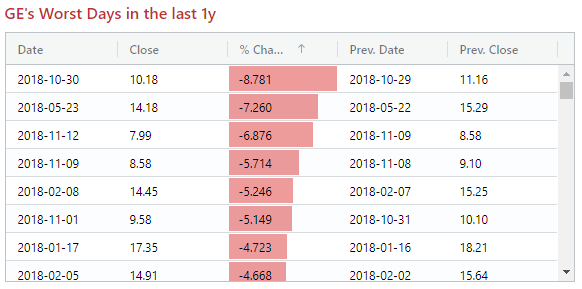General Electric Company GE is having a rare green day Tuesday, gaining more than 12 percent after the company announced a new strategic plan for its stake in Baker Hughes a GE Co BHGE. Unfortunately for GE investors, experts are saying GE’s situation may be worse than the market realizes with potential credit issues lurking under the surface.
GE said Tuesday it has set up a new framework for its relationship with Baker Hughes that involves collaborating on circular rotating equipment, sharing digital software and technology and agreeing to new terms related to Baker Hughes Digital Solutions operations and pricing. GE also plans to divest about 20 percent of its Baker Hughes investment to raise around $4 billion in capital.
Liquidity Concerns
GE stock reacted positively to Tuesday's news, but a pair of Wall Street analysts said GE stock may still be more of a risk than it seems. Gordon Haskett analyst John Inch said Tuesday the company’s liquidity problems may be getting worse.
“While GE has provided assurances that it retains 'plenty of opportunities' through asset sales, our calculations indicate most of these proceeds are already spoken for – including withdrawing GE from the commercial paper market, the Alstom put and the additional $3bn GE Capital contribution in 2019,” Inch said.
He said additional credit downgrades could make things even worse for the company by increasing costs and liquidity pressure. GE has previously said it has no plans to perform an equity capital raise, and Inch said a share price under $9 suggests the window of opportunity for such a raise has “largely shut.”
On Twitter, Guggenheim chief investment officer Scott Minerd echoed Haskett’s concerns.
“The selloff in GE is not an isolated event. More investment grade credits to follow. The slide and collapse in investment grade debt has begun,” Minerd said.
Shareholders Losing Confidence
Even with GE stock down 59.1 percent in the past year, the sell-off has intensified in recent weeks. Incredibly, four of GE’s six worst single-day market losses have occurred in the past two weeks, including an 8.7-percent drop Oct. 30 and a 6.8-percent decline Nov. 12.

GE investors are also clearly growing more impatient by the day waiting for a clear picture of new CEO Larry Culp’s full turnaround plan.
“He really needs to put some meat on the bone,” Melius Research CEO Scott Davis told Bloomberg Tuesday. “Investors want details. It’s no longer good enough to just show up and say all is fine.”
Unfortunately, Inch said things could get much worse from here. Inch reiterated his Underperform rating and $10 price target for GE stock but said shares have downside as low as $5 based on the near-term liquidity and free cash flow concerns.
GE shares traded around $8.95 at time of publication. Despite the recovery, the stock is still down about 26 percent over the past month.
Related Links:
Things Are Going From Bad To Worse For GE
GE, Baker Hughes Announce Amendments; GE To Sell Up To 20% Of BHGE Stake
Photo credit: Momoneymoproblemz (Own work), via Wikimedia Commons
© 2024 Benzinga.com. Benzinga does not provide investment advice. All rights reserved.
date | ticker | name | Price Target | Upside/Downside | Recommendation | Firm |
|---|
Trade confidently with insights and alerts from analyst ratings, free reports and breaking news that affects the stocks you care about.